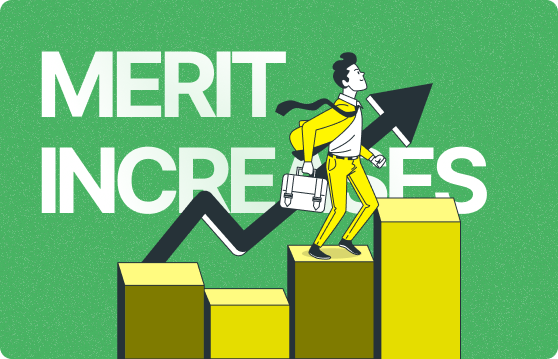The Ultimate Guide to Merit Increases: How to Reward High Performance Fairly

In today’s competitive job market, attracting and retaining top talent is more challenging than ever. Organizations are constantly seeking ways to recognize and reward their employees’ hard work and dedication. One effective method for doing this is through merit increases. This comprehensive guide will explore everything you need to know about merit increases, including how they differ from other types of pay raises, who should receive them, and how to implement a fair and consistent merit-based pay system in your organization.
What is a Merit Increase?
A merit increase is a salary raise awarded to an employee based on their performance. Unlike standard pay raises, which might be given across the board to all employees or based on tenure, merit increases are specifically tied to an individual’s contributions, achievements, and overall job performance. The goal is to reward employees who go above and beyond in their roles, providing them with financial recognition that reflects their added value to the organization.
Merit increases are an integral part of many organizations’ compensation strategies, helping to motivate employees, drive performance, and retain top talent by acknowledging the significant efforts and results achieved by high performers.
Merit Pay vs. Incentive Pay vs. Seniority Pay: Key Differences
When it comes to rewarding employees, organizations have various options, each serving different purposes. Merit pay, incentive pay, and seniority pay are three common types of compensation, each with distinct characteristics and objectives. Understanding the differences between these pay types is crucial for designing an effective compensation strategy that aligns with organizational goals and employee motivation.
Merit Pay
Merit pay is a salary increase awarded based on an employee’s performance. It is typically given as a permanent raise to the employee’s base salary, reflecting their consistent contributions, achievements, and overall job performance.
Purpose
The primary purpose of merit pay is to reward employees who demonstrate exceptional performance and consistently exceed expectations.
It is designed to recognize and financially reward individuals for their sustained contributions to the organization.
Key Characteristics
Performance-Based: Merit pay is directly tied to an employee’s performance, often evaluated through performance reviews, goal achievement, and other performance metrics.
Permanent Increase: Unlike one-time bonuses, merit pay results in a permanent increase to the employee’s base salary.
Motivational Tool: By rewarding top performers, merit pay serves as a motivational tool, encouraging all employees to strive for excellence.
Example
An employee who consistently exceeds sales targets may receive a merit increase of 5% added to their base salary, reflecting their outstanding performance.
Incentive Pay
Incentive pay is a form of compensation awarded for achieving specific targets, goals, or completing certain tasks. It is typically given as a one-time bonus or reward and does not permanently increase the employee’s base salary.
Purpose
The purpose of incentive pay is to encourage employees to achieve short-term objectives or specific outcomes that are critical to the organization’s success. It is often used to drive performance in areas that are time-sensitive or project-specific.
Key Characteristics
Goal-Oriented: Incentive pay is linked to the achievement of predefined targets, such as sales quotas, project completions, or customer satisfaction scores.
Temporary Reward: Unlike merit pay, incentive pay is a one-time reward and does not affect the employee’s base salary.
Flexible: Incentive pay can be adjusted or tailored to different roles, departments, or business needs, allowing organizations to focus on specific priorities.
Example
An employee who consistently exceeds sales targets may receive a merit increase of 5% added to their base salary, reflecting their outstanding performance.
Seniority Pay
Seniority pay is a salary increase awarded based on the length of time an employee has been with the organization. It is typically given as a periodic raise to reward loyalty and experience.
Purpose
The purpose of seniority pay is to reward long-term employees for their loyalty and tenure with the organization. It recognizes the value of experience and the contributions that come with an employee’s sustained presence within the company.
Key Characteristics
Tenure-Based: Seniority pay is not linked to performance but rather to the length of service with the organization.
Automatic Increases: Raises are often scheduled at regular intervals, such as annually, and are based on how long an employee has been with the company.
Loyalty Reward: By rewarding tenure, seniority pay encourages employee retention and loyalty, particularly in industries or roles where experience is highly valued.
Example
An employee who has been with the company for five years might receive a seniority pay increase of 3% every year, regardless of their performance, as a reward for their long-term commitment to the organization.
Summary of Differences
Merit Pay: Based on individual performance, resulting in a permanent increase to base salary. Used to reward sustained high performance.
Incentive Pay: Tied to specific short-term goals, resulting in a one-time bonus or reward. Used to drive immediate results.
Seniority Pay: Based on the length of service, resulting in regular, tenure-based increases. Used to reward loyalty and experience.
Each of these pay types serves a different purpose within an organization’s compensation strategy, and many organizations use a combination of them to ensure they reward both performance and loyalty effectively.
Who Should Get a Merit Increase?

Determining who should receive a merit increase is a critical decision that can impact employee morale, productivity, and retention. Ideally, merit increases should be awarded to employees who:
Consistently Exceed Expectations
Employees who regularly go above and beyond their job requirements should be recognized with a merit increase. This includes meeting or exceeding performance goals, contributing innovative ideas, and demonstrating leadership qualities.
Achieve Significant Milestones
Those who achieve key milestones, such as completing major projects or acquiring critical skills, should be considered for a merit increase. Their contributions often have a direct impact on the company’s success.
Demonstrate Growth and Improvement
Employees who have shown significant improvement in their performance or skills over a period of time should be rewarded. This encourages continuous development and reassures employees that their efforts to grow are recognized.
Contribute to Team Success
Employees who contribute to the success of their teams or who take on extra responsibilities to ensure team goals are met should be considered for merit increases. This fosters a culture of collaboration and mutual support.
Merit increases should not be based solely on seniority or the length of service but should reflect an employee’s contribution to the organization’s goals.
Merit Raise Methodology
Implementing a merit raise system requires a structured and fair approach to ensure that the process is transparent, consistent, and aligned with organizational goals. Below are the key steps to setting up a merit raise methodology:
1. Determine Eligibility
The first step in a merit raise methodology is determining who is eligible for a merit increase. Eligibility criteria might include:
- Performance Ratings: Employees who receive high performance ratings during their evaluations are typically eligible for merit increases. The criteria for these ratings should be clear and consistent across the organization.
- Tenure: While merit increases are based on performance, some organizations may set a minimum tenure requirement (e.g., one year of service) before an employee can be considered for a merit increase.
- Role and Level: Some organizations may limit merit increases to certain roles or levels, especially if the budget for raises is constrained. However, it’s important to ensure that this approach doesn’t create perceptions of unfairness.
By clearly defining eligibility, organizations can ensure that all employees understand who qualifies for merit increases and why.
2. Establish Merit Metrics
To fairly assess which employees deserve a merit increase, organizations need to establish clear and measurable performance metrics. These metrics should align with the organization’s goals and values and might include:
- Key Performance Indicators (KPIs): KPIs are specific, measurable goals that reflect an employee’s performance in their role. These might include sales targets, project completion rates, customer satisfaction scores, and other relevant metrics.
- Behavioral Metrics: Beyond quantitative metrics, it’s also important to assess employees based on qualitative factors like teamwork, leadership, innovation, and problem-solving abilities.
- Personal Development: Consideration should also be given to employees who have shown significant personal growth, such as acquiring new skills, taking on additional responsibilities, or completing training programs.
The metrics used should be relevant to the employee’s role and should provide a fair and comprehensive assessment of their overall contribution to the organization.
3. Grade the Goals
Once the metrics are established, the next step is to grade or evaluate employees against these goals. This grading should be done objectively and consistently, using a standardized process that ensures fairness. Consider the following approaches:
- Performance Reviews: Regular performance reviews are a common method for grading employees against their goals. These reviews should be conducted at least annually, though more frequent check-ins can provide additional opportunities for feedback and adjustment.
- Rating Scales: Many organizations use rating scales to grade employee performance, with common scales ranging from 1 to 5 or 1 to 10. Clear definitions should accompany each rating level to ensure consistency.
- Peer and Manager Feedback: In addition to formal performance reviews, gathering feedback from peers and managers can provide a well-rounded view of an employee’s performance. This can be particularly useful for assessing qualitative factors like teamwork and leadership.
Grading should be transparent, and employees should be informed of how they are being evaluated. This helps to build trust in the merit increase process and ensures that employees understand what is expected of them.
4. Check for Fairness and Consistency
Ensuring fairness and consistency in the merit increase process is crucial for maintaining employee trust and morale. This involves several key steps:
- Audit the Process: Regularly auditing the merit increase process can help identify any biases or inconsistencies. This might involve reviewing how raises are distributed across different departments, teams, or demographic groups.
- Ensure Equity: Merit increases should be distributed equitably, with all employees having an equal opportunity to earn a raise based on their performance. This includes ensuring that there is no favoritism or discrimination in the process.
- Transparency: Being transparent about how merit increases are determined can help build trust among employees. This includes clearly communicating the criteria for eligibility, the metrics used for grading, and how decisions are made.
By prioritizing fairness and consistency, organizations can create a merit increase process that is respected and trusted by employees, leading to higher engagement and satisfaction.
Setting Up a Merit Matrix
A merit matrix is a tool used by organizations to standardize the distribution of merit increases based on employee performance and other factors such as market conditions or budget constraints. There are different types of merit matrices that can be used depending on the organization’s needs.
Standard Merit Matrix
A standard merit matrix uses a grid to determine merit increases based on performance ratings and an employee’s current position within their pay range. The matrix typically includes:
Performance Ratings: The rows of the matrix represent different performance levels (e.g., exceeds expectations, meets expectations, below expectations).
Position in Pay Range: The columns represent where the employee’s current salary falls within their pay range (e.g., lower third, middle third, upper third).
Based on where an employee’s performance rating intersects with their position in the pay range, a recommended percentage increase is provided. This approach helps ensure that merit increases are aligned with both performance and market competitiveness.
Two-Variable Merit Matrix
A two-variable merit matrix is more complex and considers additional factors beyond performance and pay range. These might include:
Market Competitiveness: This variable considers how an employee’s salary compares to the market rate for similar roles. Employees who are underpaid compared to the market might receive a larger merit increase, while those who are already paid above market rates might receive a smaller increase.
Company Performance: Some organizations tie merit increases to overall company performance, adjusting the merit matrix based on factors like revenue growth, profitability, or other financial metrics.
This type of matrix allows for more nuanced and customized merit increases that take into account a broader range of factors, ensuring that raises are fair, competitive, and aligned with organizational goals.
Why Should Merit Increases Be Part of Modern HR Strategy?

Merit increases are an essential part of modern HR strategies for several key reasons. They provide a tangible reward for high performance, motivating employees to strive for excellence. When employees know that their hard work is recognized and rewarded, they are more likely to remain engaged and productive.
In a competitive job market, merit increases also play a crucial role in attracting and retaining top talent. Employees are drawn to employers that value and reward individual contributions, and merit increases offer a clear path for financial growth, which helps keep high performers within the company.
Additionally, merit increases help align employee goals with the organization’s objectives. By tying raises to specific performance metrics, organizations ensure that employees focus on areas that are critical to the company’s success.
A fair and consistent merit increase process promotes a culture of excellence within the workplace. Employees are motivated to go beyond expectations, knowing their efforts will be recognized. Furthermore, a well-designed merit increase system supports pay equity by ensuring raises are based on performance rather than tenure, favoritism, or other unrelated factors.
Incorporating merit increases into HR strategy leads to a more motivated, engaged, and dynamic workforce.
Conclusion
Merit increases are a powerful tool for recognizing and rewarding high-performing employees. By differentiating pay based on individual contributions, organizations can motivate employees, drive performance, and retain top talent. Implementing a fair and consistent merit increase process requires careful planning, clear communication, and a commitment to transparency and equity.
Organizations that successfully integrate merit increases into their compensation strategies will be better positioned to achieve their goals, attract and retain top talent, and create a culture of excellence that drives long-term success.
FAQ
Can an employee receive both a merit increase and a cost of living adjustment?
Yes, an employee can receive both a merit increase and a cost of living adjustment (COLA). The merit increase is based on performance, while the COLA is designed to help employees keep up with inflation. Receiving both allows employees to maintain their purchasing power while also being rewarded for their individual contributions.
What should be done if an employee disputes their merit increase?
If an employee disputes their merit increase, it’s important to address their concerns promptly and transparently. Employers should review the criteria and process used to determine the increase, provide a clear explanation of how the decision was made, and be open to discussing any concerns the employee may have.
How do merit increases impact employee morale?
Merit increases can significantly impact employee morale, especially when they are perceived as fair and based on transparent criteria. When employees feel that their hard work is recognized and rewarded, they are more likely to be motivated, engaged, and satisfied with their job.
What are the risks of not offering merit increases?
Failing to offer merit increases can lead to decreased employee motivation, lower productivity, and higher turnover rates. Employees may feel undervalued if their performance is not recognized, leading to dissatisfaction and a potential decline in overall organizational performance.



